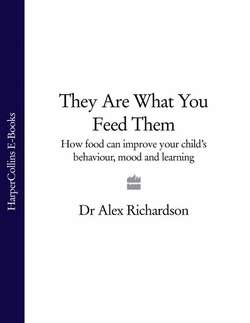Читать книгу They Are What You Feed Them: How Food Can Improve Your Child’s Behaviour, Mood and Learning - Dr Richardson Alex - Страница 33
What You Can Do to Improve Things
ОглавлениеThe advice I give to parents follows broadly the same three stages. These are the steps I’ll take you through in detail in this book. They are not difficult, and one or more of them will almost certainly apply to your child. I always emphasize that I am not officially qualified to give individuals advice on nutrition per se—and when parents need that kind of guidance, as many of them do, I always refer them to either a dietician or another suitably qualified practitioner who can advise on their child’s individual dietary needs.10
1. Your child may be consuming foods or other substances to which he reacts badly. To my mind, avoiding unnecessary additives that are suspected of causing behaviour problems is a ‘no-brainer’. You may be surprised at how many of these additives there are, but we’ll look at this issue in Chapter 6. When it comes to avoiding specific foods, then unless it’s patently obvious what’s causing the problem (and it’s not a ‘major food’) I’d advise you to seek expert advice. Improving your child’s diet and digestion should come first, as you’ll learn in Chapter 5.
‘My friend had mysterious pains since his childhood that no doctor could help. He eventually found a practitioner who advised him to focus on improving his bad digestion, and told him how to go about this. Once he changed his diet, the pains (and the grumpiness!) went away.’—June
2. Your child may be ‘hooked’ on sweet, sugary and starchy foods. A diet containing too many refined starches and sugars is guaranteed to wreak havoc with the fuel supply to your child’s brain—swinging him or her on a rollercoaster of energy ‘highs’ and ‘lows’ throughout the day. The same ‘fast-action’ foods and drinks are also damaging your child’s digestive and immune systems, which can lead to a whole array of health-related problems that may be closely linked to difficulties in mood, behaviour and learning. In Chapter 7, we’ll see what foods you and your child can eat (and which ones to avoid) to ensure balanced, calm energy throughout the day.
3. Your child probably eats too many ‘bad fats’ and not enough ‘good fats’. This is a very easy one for me to identify, not only because it’s even more common than the sugar and ‘energy imbalance’ problems, but also because my own specialist research to date has been focused mainly in this area. ‘Bad fats’ are found in many processed foods and margarines. The ‘good fats’ include the very special omega-3 fats (EPA and DHA) which are found in fish and seafood, and are absolutely essential to brain development and function. In Chapter 8 you’ll learn how to ‘get the fats right’, and in Chapter 9 I’ll take you through the latest research into omega-3 for child behaviour and learning, sorting the facts from the myths and explaining what the research has—and hasn’t—shown.
Facing the facts isn’t always easy—but as we’ve seen in this chapter, you can’t rely on the ‘powers that be’ to look after your child’s interests where issues of food and diet are concerned. However, there are some simple steps that you can take to help your child—the first of which is getting informed. In the next chapter we’ll look at some of the labels that are often given to children with behaviour or learning problems, and see how diet may relate to these. Then we’ll look at essential nutrients and digestion (these really are the basics you need to understand) before moving on to the chapters that will take you through the three main steps I’ve outlined above. In the last few chapters of the book we’ll focus on putting what you’ve learned into practice.
